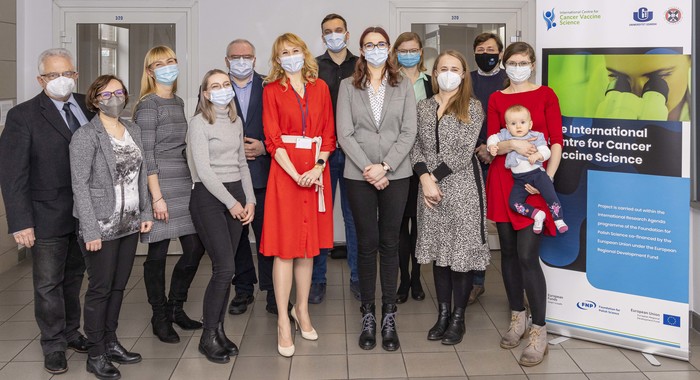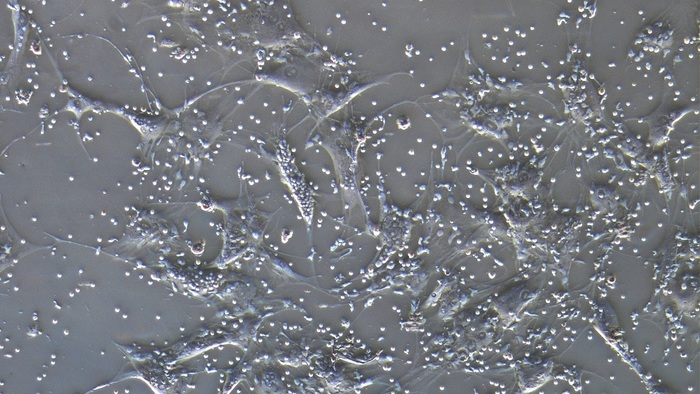Cell-to-cell interactions are the subject of a publication in "Nature Communications"
15.02.2022
Researchers from the Medical University of Gdańsk, the International Cancer Vaccine Research Center (ICCVS) of the University of Gdańsk, the Medical University of Łódź (UMED) and PolTREG S.A. observed that mesenchymal stem cells (MSCs) donate their mitochondria to regulatory T cells (Treg). This phenomenon significantly increases the activity of the latter and can be used in therapy. The researchers described the results of their research in an article entitled Mesenchymal stem cells transfer mitochondria to allogeneic Tregs in an HLA-dependent manner improving their immunosuppressive activity published in the journal Nature Communications (IF 14.919). The observed dependencies have also become the subject of patent applications of the MUG, UG and PolTREG S.A. filed with the European Patent Office (EPO).
The originator and coordinator of the research is Prof. Natalia Marek-Trzonkowska from the Division of Family Medicine of the MUG, Director of ICCVS UG. All the described studies were performed in Poland as part of Polish grants. The thesis is part of the doctoral dissertation by Karolina Piekarska, M.A. from the Division of Family Medicine of the MUG.

from the left: Prof. Janusz Siebert (Division of Family Medicine of the MUG), Adriana Schumacher, Ph.D. (Department of Pharmacology of the MUG), Hanna Zielińska, Ph.D. and Justyna Sakowska, M.A. (Department of Medical Immunology of the MUG), Jan Spodnik, Ph.D. (Division of Anatomy and Neurobiology of the MUG), Prof. Natalia Marek-Trzonkowska (ICCVS UG and Division of Family Medicine of the MUG), Łukasz Arcimowicz, M.A. (ICCVS UG), Karolina Piekarska, M.A. (Division of Family Medicine of the MUG), Małgorzata Kurkowiak, Ph.D. (ICCVS UG), Iwona Pelikant-Małecka Ph.D. (Division of Medical Laboratory Diagnostics of the MUG), Prof. Piotr Trzonkowski (Department of Medical Immunology of the MUG), Zuzanna Urban-Wójciuk, Ph.D. with the youngest member of the team – her daughter Ula (ICCVS UG). 4 authors are missing in the photo: Prof. Ted Hupp (ICCVS UG), Prof. Ewa Słomińska (Department of Biochemistry of the MUG), Bogusław Tymoniuk, M.A. (Department of Immunology and Allergy, Medical University of Łódź) and Dr. Habil. Alicja Renkielska (Division of Plastic Surgery of the MUG).
– This work shows how one (initially quite crazy) idea can suddenly sprout and unfold unexpectedly in many dimensions. First, the two of us worked with Karolina. These were days and nights in the laboratory. We often wondered if what we were doing still made sense, or if we had already gone beyond common sense. I will not forget Karolina’s eyesight when I decided to additionally freeze something, bank it. But when the first evidence appeared that what we had initially only sensed was actually happening, I began to wonder what I should do to prevent this discovery from going unnoticed. What is missing in our research? What else should we check? – says Prof. Marek-Trzonkowska.
Cell therapies can become a safe and effective method of treating many human diseases, including cancer, autoimmune diseases or excessive inflammatory reactions that take place in sepsis or during viral infections (including COVID-19). To achieve this goal, it is essential to know the mechanisms of intercellular communication in order to predict the behavior of cells when administered to a patient. Treg lymphocytes make up a unique population in the immune system. Contrary to the so-called conventional T lymphocytes do not fight pathogens, but inhibit the action of other cells of the immune system. This phenomenon is undesirable in patients with an existing neoplastic disease. However, Treg cells are necessary to protect us against the development of autoimmune and allergic diseases. They are also needed for tolerance of the transplanted organs to develop. On the other hand, MSCs are multipotent (that can differentiate into different types of cells, e.g. osteoblasts, glial cells, chondrocytes) non-hematopoietic progenitor cells that occur in the body of all of us. Their rich source is, among others fat tissue.

Three-day co-culture of Treg (small cells) and MSC (large cells) lymphocytes; in the center there is an MSC cell covered with Treg lymphocytes
In the present work, scientists have shown that the contact of Treg lymphocytes with allogeneic (ie from a different donor) MSC cells enhances the immunosuppressive effect of Treg cells. Treg lymphocytes cultured in the presence of MSC inhibit the multiplication of conventional T lymphocytes much more strongly and are able to rapidly break down ATP and AMP in the extracellular environment, leading to the accumulation of tolerogenic adenosine. This phenomenon can therefore be used in the treatment of autoimmune diseases (e.g. type 1 diabetes, multiple sclerosis or rheumatoid arthritis) and to induce tolerance of transplanted organs. At the same time, if similar relationships take place in the tumor environment between autologous cells, it means that inhibiting this interaction could become an element of the fight against cancer. Scientists have shown that MSCs transfer their mitochondria and cell membrane fragments to Treg lymphocytes, and that this phenomenon depends on HLA antigens. As the research results show, the more intensively MSCs pass on active mitochondria to Treg cells, the more they differ in their HLA antigens.
– Our research, however, flowed out into the wide waters through numerous weaves of circumstances. It happened thanks to the combination of the work of scientists from three universities, i.e. MUG, UG, Medical University in Łódź and PolTREG S.A. Working in a multidisciplinary team with people who were all curious about where this research would lead us and who did not ask what time it was, we managed to get our research published in Nature Communications – explains Prof. Marek-Trzonkowska. – Only the people mentioned among the authors and their families know how long we have gone from research, through data analysis, drawing up figures, discussing with reviewers, and performing additional analyzes. I am very glad that MSC cells and Treg lymphocytes took us on this amazing journey and showed us some scenes from their secret life. I hope that the fascination with how cells behave will never leave me or the people who work with me. Curiosity and enthusiasm are simply essential in the work of a scientist.
photo by Paweł Sudara/MUG
Archives
- Academic Year 2024/2025
- Academic Year 2023/2024
- Academic Year 2022/2023
- Academic Year 2021/2022
- Academic Year 2020/2021
- Academic Year 2019/2020
- Academic Year 2018/2019
- Academic Year 2017/2018
- Academic Year 2016/2017
- Academic Year 2015/2016
- Academic Year 2014/2015
- Academic Year 2013/2014
- Academic Year 2012/2013